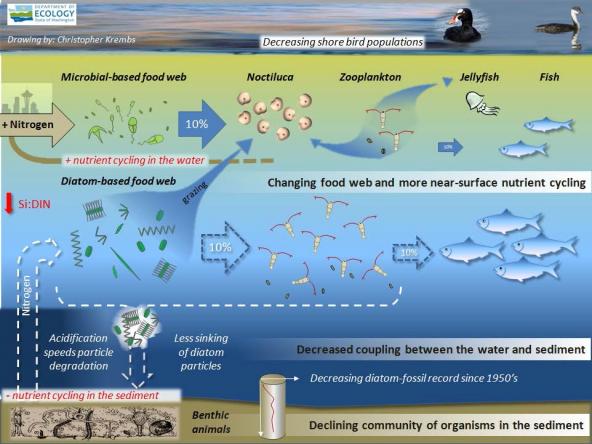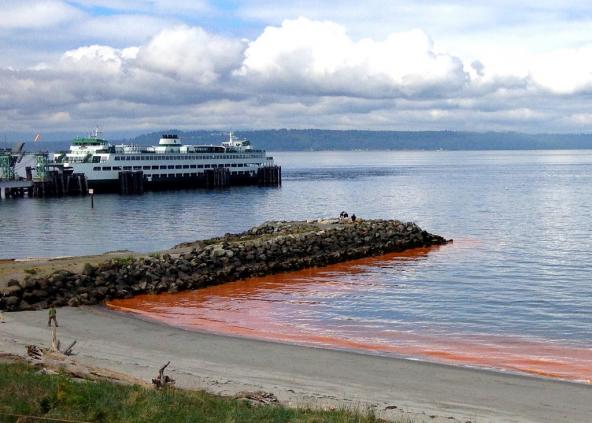
Researchers are studying how persistent pollutants such as PCBs avoid settling to the bottom of Puget Sound. This article continues our coverage of new theories on the spread of toxic chemicals in the food web.

Toxic pollutants that reach Puget Sound tend to remain in suspension and sink slowly to the bottom for a variety of reasons, according to Jim West, a researcher with the Washington Department of Fish and Wildlife who has been studying the biological transfer of contaminants.
The overall effect is that, compared to other major waterways, more toxic compounds in Puget Sound wind up in the tissues of animals in the pelagic food web — the free-swimming creatures living in open waters.

Because many of these chemicals are hydrophobic (repelled by water), they tend to quickly attach to living organisms or else dead organic material. Puget Sound is particularly known for its accumulation of polychlorinated biphenyls, or PCBs, from plankton at the bottom of the food web to top predators, such as killer whales. Krill, a tiny crustacean that eats plankton and organic matter, can break apart PCB-laden particles, reducing the sinking rate.
Another factor is stratification, or the layering of waters, for which Puget Sound is well known. Layers are formed as incoming freshwater tends to float on top of the heavier seawater. At the interface between the layers, sinking particles are delayed by the abrupt shift in density. A vast array of tiny particles may accumulate into wispy clouds of flocculent that generally stay in one place.
“It is known to be an intensively active place for organisms to feed,” West said, “and the PCBs are being concentrated in this location.”
Yet another factor that could keep PCB-laden particles from sinking to the bottom is the uptake by plankton that float rather than sink.
Christopher Krembs, an oceanographer with the Department of Ecology, has been gathering evidence for a hypothesis that suggests that Puget Sound is undergoing a surge in dinoflagellates, which have two tail-like flagella, at the expense of diatoms, which are encased in a silica container called a frustule.
Because of their heavy silica shell, diatoms tend to sink at a rapid rate. Dinoflagellates, which can eat diatoms and other phytoplankton, tend to float after they die, keeping any associated toxic chemicals at or near the surface.
Among the dinoflagellates are several that produce natural toxins that can accumulate in shellfish at levels dangerous to humans. Those toxins are monitored carefully by state and county health authorities. Noctiluca, a nontoxic group of dinoflagellates, is well known for painting the surface of Puget Sound orange as the organisms die and cluster together in huge floating masses.

Evidence for a decline in sinking diatoms can be found in deep layers of sediment, which show a decline in silica starting about 1950, according to studies by Jill Brandenberger of Battelle’s Marine Science Laboratory in Sequim.
The reason for the rise of dinoflagellates and the fall of diatoms remains unclear, but Krembs believes it may be related to excess nitrogen in Puget Sound at specific times, spurring the growth of plankton. Sources of nitrogen from people include sewage-treatment plants, septic systems and lawn fertilizers.
Under current conditions, diatoms, which require silica as well as nitrogen, may be unable to grow as rapidly as the dinoflagellates that eat them, Krembs said. While diatoms play an important role in the food web, few creatures consume the dinoflagellates, perhaps because they can carry high concentrations of ammonia.
The fate of man-made contaminants bound up in dinoflagellates has not been fully explored, but they are likely to be cycled back through the food web during decomposition at or near the surface, West said.
Some proportion of contaminants will settle to the bottom over time. The amount can vary according to changing conditions at each location. The factors involved are not well understood, researchers say. What they have discovered, however, is that PCBs and other toxic chemicals seem to keep cycling through the pelagic food web much longer than previously expected.

